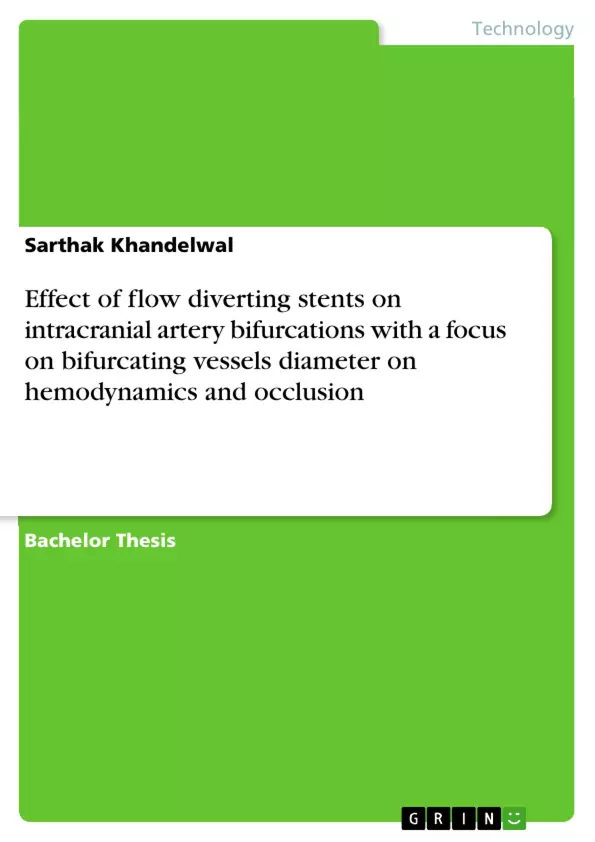An intracranial aneurysm is a vascular disorder estimated to affect up to 5% of the global population. The use of flow diverting stents for treatment of intracranial aneurysms leads to ischemic complications. It is hypothesized that alteration in hemodynamics after placement of stents plays a vital role in ischemia (vessel occlusion). This project uses Computational Fluid Dynamics to study the alterations in hemodynamics before and after placement of stent with respect to the relative diameter of the bifurcating arteries on idealized geometries using ANSYS-CFX 15.0. Pressure and flow rate waveforms were extracted from a 1D model of the arterial tree to simulate hemodynamic conditions correctly. The results show that there are significant changes in hemodynamics (pressure and wall shear stress) before and after placement of stent. These changes are also affected by the relative diameters of the bifurcating arteries. The trends observed in hemodynamics can be interpreted by clinicians to study vessel occlusion and its relation to the relative diameters of arteries. The results have a potential to assist in treatment of aneurysms without ischemic complications.
Inhaltsverzeichnis (Table of Contents)
- Summary
- Nomenclature
- Contents
- Acknowledgements
- 1 INTRODUCTION
- 1.1 Clinical Background/ Theory
- 1.2 Motivation
- 1.3 Hemodynamic variables
- 1.4 Computational Fluid Dynamics (CFD)
- 2 THESIS
- 2.1 Literature Review
- 2.2 Preliminary Work
- 2.2.1 Steady state analysis and Laminar flow
- 2.2.2 Geometry
- 2.2.3 Properties of Blood
- 2.2.4 Parabolic velocity profile
- 2.2.5 Rigid walls assumption
- 2.2.6 Mesh structure
- 2.2.7 Boundary conditions
- 2.3 Porosity model
- 2.4 Methodology
- 3 RESULTS
- 3.1 Unstented
- 3.1.1 Pressure
- 3.1.2 Wall Shear Stress
- 3.2 Stented
- 3.2.1 WSS Average 1
- 3.2.2 WSS Average 2
- 3.2.3 Pressure Inlet
- 3.2.4 Average Pressure 1
- 3.2.5 Average Pressure 2
- 3.3 Stented vs Unstented
- 3.3.1 Stent Small Artery (A2) vs Unstented
- 3.3.2 Stent Big Artery (A1) vs Unstented
- 3.1 Unstented
- 4 VALIDATION
- 4.1 Mesh independency
- 4.2 Wall Shear Stress
- 5 DISCUSSION
- 6 CONCLUSION
- REFERENCES
Zielsetzung und Themenschwerpunkte (Objectives and Key Themes)
This project aims to investigate the effects of flow diverting stents on intracranial artery bifurcations, particularly focusing on the influence of bifurcating vessel diameter on hemodynamics and the potential for vessel occlusion. By using Computational Fluid Dynamics (CFD), the study analyzes alterations in hemodynamics before and after stent placement to identify potential factors contributing to ischemia.
- The impact of flow diverting stents on intracranial artery bifurcations.
- The role of bifurcating vessel diameter in influencing hemodynamics.
- The potential relationship between altered hemodynamics and vessel occlusion.
- The use of CFD to analyze hemodynamic changes and predict potential ischemic complications.
- The application of the study's findings to improve treatment strategies for intracranial aneurysms.
Zusammenfassung der Kapitel (Chapter Summaries)
The first chapter introduces the clinical background of intracranial aneurysms and their treatment using flow diverting stents. It also discusses the motivation for this research and the key hemodynamic variables involved, including pressure and wall shear stress. The chapter concludes with a brief overview of Computational Fluid Dynamics (CFD) as a tool for analyzing blood flow.
The second chapter delves into the methodology of the research, including a literature review, preliminary work, and the development of a porosity model to represent the stent. The chapter discusses the assumptions made, the geometry used, and the boundary conditions applied in the CFD simulations.
The third chapter presents the results of the CFD analysis, focusing on the changes in hemodynamics observed before and after stent placement. The results are analyzed based on different diameter ratios of the bifurcating arteries and are categorized into unstented and stented conditions. The chapter highlights the significant variations in pressure and wall shear stress observed in response to stent placement and diameter ratios.
The fourth chapter validates the accuracy of the CFD simulations by conducting a mesh independency study and comparing the simulated wall shear stress values to theoretical calculations.
Schlüsselwörter (Keywords)
The key terms and concepts explored in this research include intracranial aneurysms, flow diverting stents, hemodynamics, wall shear stress, pressure, vessel occlusion, ischemia, CFD, porosity model, and diameter ratios.
- Citar trabajo
- Sarthak Khandelwal (Autor), 2015, Effect of flow diverting stents on intracranial artery bifurcations with a focus on bifurcating vessels diameter on hemodynamics and occlusion, Múnich, GRIN Verlag, https://www.grin.com/document/311665



